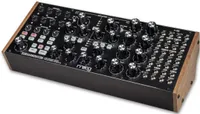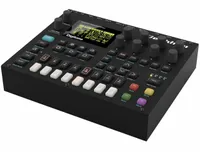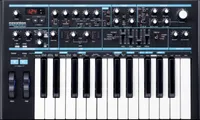10 Cool Synths Under $1,000 you can snap up on eBay
Now's the perfect time to revamp your studio on a budget!

Hardware vs plug-ins?
If you’ve grown up on a diet of plug-ins and soft-synths, entering the world of hardware can be a revelation.
There’s something immeasurably tactile and intuitive about simply turning a knob or pushing a fader and hearing the sound you’ve created begin to twist and turn in a way that a mouse and keyboard could never truly replicate.
There’s also a lot to be said about working with some creative limitations; sure, in your DAW you can feasibly access any sound you can think of, but working within the constraints of a dedicated synth that does a limited number of things exceptionally well can inspire you in different ways.
In this guide we’ve rounded up 10 cool synths you can pick up for under $1,000. Each of the models we’ve found will instantly elevate your sound, but also provide a much more expressive way of interacting with your music. We’ve found a mix of all-time classics, under-rated gems and even found a wild card or two to keep things interesting.
It turns out a budget of $1,000 gives you plenty of choice, with a huge range of interesting, exciting synths all available at (or under) this price point. Let’s get started.
Korg Minilogue XD
The first on the list, and arguably already on its way to all-time great status, is the Korg Minilogue XD. This four-voice poly synth, with a hybrid analog/digital engine, forms part of a wider range featuring the Monologue and Prologue, and delivers incredible performance for not a lot of cash.
There are a couple of variants, but we’ve opted for the XD version on account of its additional effects and enhanced sequencer. These crop up fairly often on the used market, for the simple reason that they’re many people’s first ‘proper’ synth. And, as an introduction to the techniques and workflow of hardware synthesis, there are few better options.
Behringer Deepmind
We’ve all seen the Behringer synth stable grow in recent years, thanks to ‘homage’ models of classic gear from yesteryear, yet in the Deepmind it has its own original IP synth line that goes somewhat under the radar.
Available in both six and 12 voices versions, with a desktop module also part of the range, the Behringer Deepmind is a seriously under-rated synth which, with a different name on the box, would surely command a higher fee.
What you get is two digitally-controlled analog oscillators, with LFOs, envelopes, a sequencer and a selection of TC Electronic effects making for a pretty comprehensive package. It’s also, by some distance, the largest synth we’ve included here so plan your space accordingly…
Moog Subharmonicon
While some of the synths on this list are simple beasts, others – like the Moog Subharmonicon – take a bit of explaining. It’s worth your time persevering though, because tucked away under all the initial complexity is one of the most fun, rewarding and experimental instruments you can wish for. Essentially, the Subharmonicon is a six oscillator monosynth with Moog’s classic ladder filter and 32 patch points for routing signals, but the real joy comes from the sequencing possibilities.
Without going into major detail – we’d run out of space – what the Subharmonicon does is provide you with the ability to create polyrhythms, i.e. two cyclical sequences which run at different – yet still completely musical – subdivisions of the master tempo, or of the steps preceding it. It’s basically a ‘happy accident’ factory, where five minutes of knob twiddling can lead you on a journey like few other synths. It’s not for everyone, but for anyone with an eye for musical adventure the Moog Subharmonicon is a real treat.
Moog Grandmother
Of course, while some synth fans crave sonic exploration, others crave something slightly more immediate, in a musical sense. The Moog Grandmother is, in our eyes, one of the finest examples of what a well-made, superb sounding monophonic synth can bring to the table.
From harmonically rich pads using the on-board spring reverb to squelchy bass sounds, the Grandmother is on its way to becoming synth royalty. Like the Subharmonicon, the Grandmother also introduces CV patch points so you can begin to create interesting routing within the synth, or even by hooking it up to external modular gear. It’s arguably not the most versatile on the list, but when your core sound is as good as the Grandmother’s is it’s hard to argue against its inclusion here.
Arturia Microfreak
If you’re just getting into the joys of synthesis, you possibly don’t realise we’re arguably living in a golden age. At every price point, and for every style of music, there are some amazing, innovative instruments coming out which are taking synthesis in entirely new directions.
The Arturia Microfreak is a great example; aside from its unique PCB keyboard, the Microfreak is interesting because it packs in 16 different oscillator modes, an analog filter section, sequencer and fully routable internal modulation tools.
Modular fans will be curious to explore the Microfreak, not least because it was largely inspired by Mutable Instruments’ Plaits Eurorack module. This, in addition to a free firmware update that added new oscillator modes from Noise Engineering, adds up to a hugely capable, credible synth that represents superb value for money.
Korg Opsix
Mention the phrase ‘FM synthesis’ to many synth players and they’ll shudder. Not because FM produces bad sounds – far from it – but it is not the easiest concept around which you can wrap your head. Frequency modulation, or FM, is a method whereby the frequency of one source, like an oscillator, modulates another.
This could be its pitch, or its attack and delay envelope, or any number of other parameters. When you start chaining these sources you can get some interesting sounds, from bells and percussion at less extreme settings through to evolving, ambient pads where the sound seems to move and breathe on its own.
The Korg Opsix is a great example of a modern FM synth, with some neat features designed to make the FM learning curve more bearable. We also liked the sequencer but, in reality, the true joy of FM is in creating a patch and letting it interweave to create something unique.
Roland JU-06a
Synth fans of a certain generation will naturally be drawn to anything that resembles the classic Roland models of the 80s. With the Roland JU-06a, the sounds of the iconic Juno 60 and Juno 106 are recreated, accurately, and shrunken down to fit in even the most cramped of studios.
It would be easy to look at the small footprint of the JU-06a and assume it’s a toy, but allow yourself to believe! It is as fun as it looks, and sounds as good as you would hope.
The ‘a’ in the title refers to the built-in arpeggiator, which means you can be playing those eerie Stranger Things arps within seconds, while the addition of chorus and delay means it truly realizes those iconic warbled 80s pad sounds like few others.
Teenage Engineering OP-1
Admittedly we’re pushing the barriers of the self-imposed price limit here, but stick with us. The Teenage Engineering OP-1 is a modern marvel. A synth masterpiece. A peerless tool for next-level creativity and inspiration. It is also, it must be said, not cheap. We’ve included it however, because you can often pick these up used for under $1,000 and, if you can afford it, they are absolutely worth the outlay.
The OP-1 is great because it has everything you need to produce full music tracks without setting foot near a computer. This aesthetically pleasing thin, gray rectangle packs in synth and percussion voices, a sampler, sequencer, mixer and recorder, along with an FM radio for capturing external sounds. It’s quick and intuitive to use, and is small enough that you can take it anywhere.
Elektron Digitone
Elektron is perhaps better known for its drum machines, grooveboxes and samplers, but with the Digitone it showed it has some serious chops in the synth arena too. What you’ll get is a simple enough four-operator FM synth engine with eight-note polyphony and four dedicated tracks. Where the Digitone comes alive, however, is when you start to integrate some of Elektron’s famous sequencing capabilities.
For the uninitiated, this can be a complex process but is well worth committing to. By implementing per-note probability, modulation, effects or more, you can begin to create some truly unique sounds which you’d struggle to recreate using other gear. If you’re looking to bravely explore new frontiers of sound, this could be the one for you.
Novation Bass Station II
Rounding off the list is an old-school classic. The Novation Bass Station II has been around for a while but its simple two-oscillator design still hits hard in 2021. What perhaps get overlooked, however, is the Bass Station’s versatility. Sure, it does bass – the clue is in the name – but it’s not difficult to coax outstanding lead and pad sounds which can provide that extra secret sauce to a track.
We’re also big fans of the way Novation continues to add to the Bass Station’s arsenal with the release of new firmware. A recent update introduced AFX mode, which added an entire new workflow to it based on the distinctive style of Aphex Twin. It is, depending on how you employ AFX mode, completely captivating or utterly crazy, but you could never call it boring. Put simply, there aren’t many analog monosynths at this price point which can rival the Bass Station for features, fun or experimentation.
Want all the hottest music and gear news, reviews, deals, features and more, direct to your inbox? Sign up here.
MusicRadar is the number one website for music-makers of all kinds, be they guitarists, drummers, keyboard players, DJs or producers...
- GEAR: We help musicians find the best gear with top-ranking gear round-ups and high-quality, authoritative reviews by a wide team of highly experienced experts.
- TIPS: We also provide tuition, from bite-sized tips to advanced work-outs and guidance from recognised musicians and stars.
- STARS: We talk to musicians and stars about their creative processes, and the nuts and bolts of their gear and technique. We give fans an insight into the craft of music-making that no other music website can.










